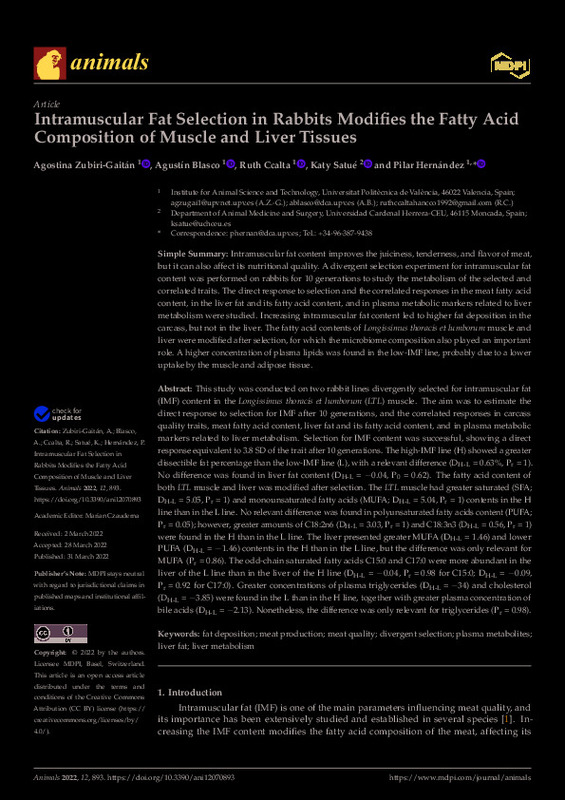|
Resumen:
|
[EN] Simple Summary Intramuscular fat content improves the juiciness, tenderness, and flavor of meat, but it can also affect its nutritional quality. A divergent selection experiment for intramuscular fat content was ...[+]
[EN] Simple Summary Intramuscular fat content improves the juiciness, tenderness, and flavor of meat, but it can also affect its nutritional quality. A divergent selection experiment for intramuscular fat content was performed on rabbits for 10 generations to study the metabolism of the selected and correlated traits. The direct response to selection and the correlated responses in the meat fatty acid content, in the liver fat and its fatty acid content, and in plasma metabolic markers related to liver metabolism were studied. Increasing intramuscular fat content led to higher fat deposition in the carcass, but not in the liver. The fatty acid contents of Longissimus thoracis et lumborum muscle and liver were modified after selection, for which the microbiome composition also played an important role. A higher concentration of plasma lipids was found in the low-IMF line, probably due to a lower uptake by the muscle and adipose tissue. This study was conducted on two rabbit lines divergently selected for intramuscular fat (IMF) content in the Longissimus thoracis et lumborum (LTL) muscle. The aim was to estimate the direct response to selection for IMF after 10 generations, and the correlated responses in carcass quality traits, meat fatty acid content, liver fat and its fatty acid content, and in plasma metabolic markers related to liver metabolism. Selection for IMF content was successful, showing a direct response equivalent to 3.8 SD of the trait after 10 generations. The high-IMF line (H) showed a greater dissectible fat percentage than the low-IMF line (L), with a relevant difference (DH-L = 0.63%, P-r = 1). No difference was found in liver fat content (DH-L = -0.04, P-0 = 0.62). The fatty acid content of both LTL muscle and liver was modified after selection. The LTL muscle had greater saturated (SFA; DH-L = 5.05, P-r = 1) and monounsaturated fatty acids (MUFA; DH-L = 5.04, P-r = 1) contents in the H line than in the L line. No relevant difference was found in polyunsaturated fatty acids content (PUFA; P-r = 0.05); however, greater amounts of C18:2n6 (DH-L = 3.03, P-r = 1) and C18:3n3 (DH-L = 0.56, P-r = 1) were found in the H than in the L line. The liver presented greater MUFA (DH-L = 1.46) and lower PUFA (DH-L = -1.46) contents in the H than in the L line, but the difference was only relevant for MUFA (P-r = 0.86). The odd-chain saturated fatty acids C15:0 and C17:0 were more abundant in the liver of the L line than in the liver of the H line (DH-L = -0.04, P-r = 0.98 for C15:0; DH-L = -0.09, P-r = 0.92 for C17:0). Greater concentrations of plasma triglycerides (DH-L = -34) and cholesterol (DH-L = -3.85) were found in the L than in the H line, together with greater plasma concentration of bile acids (DH-L = -2.13). Nonetheless, the difference was only relevant for triglycerides (P-r = 0.98).
[-]
|
|
Agradecimientos:
|
This research was funded by the Spanish Ministry of Science and Innovation, project number PID2020-115558GB-C21, and by the Conselleria for Innovation, Universities, Science and Digital Society, project number AICO/2020/349.[+]
This research was funded by the Spanish Ministry of Science and Innovation, project number PID2020-115558GB-C21, and by the Conselleria for Innovation, Universities, Science and Digital Society, project number AICO/2020/349.
[-]
|









